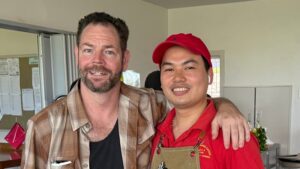
When Lisa Ross’s daughter fell ill, it took three weeks to secure an appointment with a GP in their regional town in Western Victoria. This experience prompted the Horsham physiotherapist to return to university to study medicine. At 40, she enrolled at Deakin University and moved her family to Geelong. However, in her second year, the stress of juggling full-time studies, family life, and a mortgage became overwhelming.
“I had to make the decision for the mental health of our family and lifestyle to pause my medical studies for a year,” Ross explained. She has since returned to university but finds the financial strain significant, as she can only work a few hours a week. “We’re having to decide between the kids doing swimming lessons or not,” she said, emphasizing the inequity faced by those with financial burdens or career commitments.
Ross has written to her medical school’s dean, advocating for part-time study options. Currently, no Australian medical schools offer this flexibility. “I don’t want other parents to avoid studying medicine for their communities due to these challenges,” she stated.
Global Trends and Local Challenges
Globally, most medical degrees are full-time, but some universities are experimenting with part-time programs. The University of Edinburgh recently graduated its first cohort of part-time medical students, marking a first for the UK.
Medical Deans Australia and New Zealand president Stuart Carney acknowledged the need for flexible study options and noted that Australian medical schools are exploring ways to implement part-time programs. “We’ve established a working party to review evidence and identify effective strategies from other countries,” Carney said.
Government and Institutional Responses
A spokesperson for the Department of Education stated that the federal government does not restrict part-time study for medical students. “The government is working with the university sector to understand barriers to part-time study,” the spokesperson noted.
Deakin University Doctor of Medicine course director Karen D’Souza mentioned that the university would consider part-time options once the federal government reviews the funding model. “Currently, each medical school must meet a government quota for graduating students on Commonwealth Supported Places (CSP),” she explained.
Financial Strain and Student Advocacy
Financial pressures significantly affect medical students. A survey of 200 Deakin University medical students found that nearly 90% reported financial precarity negatively impacting their learning and wellbeing. Additionally, 36% cited caring responsibilities as a challenge.
Medical students are also excluded from the Commonwealth Prac Payment, which provides financial support to students in other fields during mandatory placements. The Australian Medical Students Association (AMSA) has been advocating for medical students to be eligible for this payment. AMSA president Melody Ahfock believes part-time study could diversify the medical workforce and support struggling students.
“The cohort likely to benefit from part-time options is also the cohort that would benefit from the Commonwealth Prac Payment,” Ahfock said.
Steps Toward Flexible Learning
Some universities are already adapting their programs to offer more flexibility. Deakin University has adjusted its timetable to spread classes over three and a half days instead of five and allows students to access lectures online.
Stuart Carney emphasized the importance of flexible learning to support mature-aged students, many of whom choose general practice. Older graduates and those with dependent children are more likely to pursue general practice, according to the Medical Schools Outcome Database.
Graduates aged 35 to 39 are twice as likely to prefer general practice compared to the overall average.
Looking Ahead
While changes may not occur in time for her own studies, Lisa Ross hopes future medical students will benefit from more flexible learning options. “I want to come out the other end with my family intact, to be a great doctor, and to serve regional communities,” she expressed.
As Australian medical schools and the government continue to explore part-time study options, the hope is to alleviate the financial and personal burdens on students, ultimately leading to a more diverse and resilient healthcare workforce.







